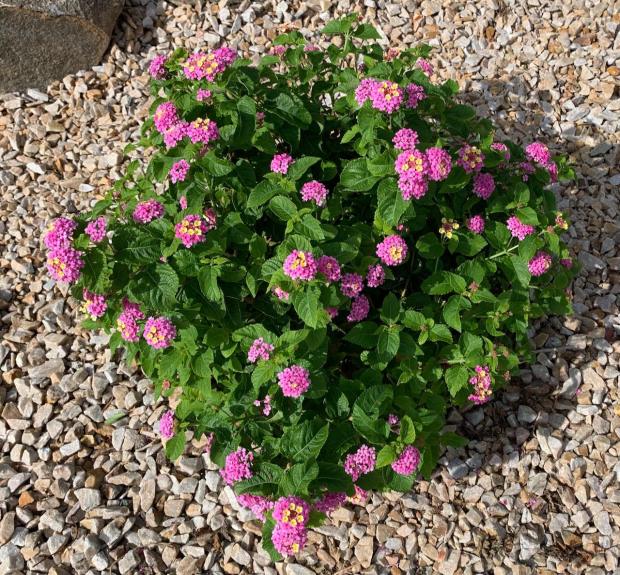Lantana spp
In the Phoenix area you mostly see Lantana montevidensis or hybrid cultivars of L. montevidensis and L. camara. Common names include Trailing Lantana and Lantana. The form and shape of lantana hybrids can vary widely, which expands its use potential in the landscape.
Attracts Pollinators: Lantana flowers are rich in nectar, attracting a variety of pollinators like butterflies and bees. The bright colors make it a popular choice for pollinator gardens.
Global Distribution: Lantana is native to tropical regions of the Americas, Africa, and parts of Asia. It has become naturalized in many other regions due to its adaptability and attractiveness as an ornamental plant.

Flowers: J F M A M J J A S O N D
Status: Naturalized
Origin: Tropical America
Family: Verbenaceae
Size: Varies
Sun: Full to part shade
Watering: Regular water
Growth Rate: Fast
Soil: Tolerant
Temperature: Frost and freeze sensitive
Pruning: Head back in spring after last chance of frost.
Disease and Pests: White Flies in late summer and early fall
Uses: Excellent nectar plant for bees and butterflies.
Notes: Some common hybrids and cultivars include ‘Tangerine’, ‘Irene’, ‘Carnival’, ‘Gold Mound’, ‘Radiation’, ‘Spreading Sunshine’ and ‘Trailing Yellow’. Some species can be toxic if ingested.

In Maricopa County the average first frost date varies from Nov 21st to Dec 12th. In Tucson the average first frost date is Dec 3rd.
- Keep plants well watered
- Place plants in a protected microclimate
- Protect by covering plants, adding heat or increasing air circulation
- Do not prune frost damage until plants begin growing
For more info: Protecting Frost Sensitive Plants
Resources
Gardens and Landscapes: Transform your garden into a gallery of personalized narratives, providing valuable information to both seasoned gardeners and curious visitors.
Public Spaces and Parks: Enhance the educational aspect of public spaces by introducing engraved tags. Create interactive learning experiences that engage and inform visitors about the diverse flora and fauna in the area.
Commercial Landscapes: For businesses looking to add a touch of sophistication to their outdoor spaces, and to communicate your commitment to nature.
Nature Reserves and Conservation Areas: Support conservation efforts by providing informative markers in nature reserves. Raise awareness about the importance of biodiversity and conservation.
Educational Institutions: Create interactive outdoor classrooms by incorporating our tags into educational institutions. Foster a love for nature and a thirst for knowledge among students of all ages.
Create your custom tags today – available in our Shop!

